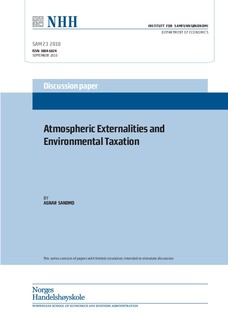| dc.contributor.author | Sandmo, Agnar | |
| dc.date.accessioned | 2010-11-15T14:27:41Z | |
| dc.date.available | 2010-11-15T14:27:41Z | |
| dc.date.issued | 2010-09 | |
| dc.identifier.issn | 0804-6824 | |
| dc.identifier.uri | http://hdl.handle.net/11250/163238 | |
| dc.description.abstract | The paper reviews the theory of environmental taxation under first best and second best
conditions. It argues that negative environmental externalities lead to reductions of the
provision of public goods, while investment in abatement increases the supply of public
goods. Together with optimal tax rules, the paper therefore also derives conditions for the
optimal use of resources on abatement. After brief discussions of the dimensions of time and
uncertainty, tax reform and the double dividend, and taxes versus quotas, the optimal tax
model is applied to the problem of global warming with a discussion of the particular
incentive problems that arise in designing and implementing global climate policy. | en |
| dc.language.iso | eng | en |
| dc.publisher | Norwegian School of Economics and Business Administration. Department of Economics | en |
| dc.relation.ispartofseries | Discussion paper | en |
| dc.relation.ispartofseries | 2010:23 | en |
| dc.subject | environmental economics | en |
| dc.title | Atmospheric externalities and environmental taxation | en |
| dc.type | Working paper | en |
| dc.subject.nsi | VDP::Landbruks- og Fiskerifag: 900::Landbruksfag: 910::Naturressursforvaltning: 914 | en |
| dc.subject.nsi | VDP::Samfunnsvitenskap: 200::Økonomi: 210::Samfunnsøkonomi: 212 | en |
